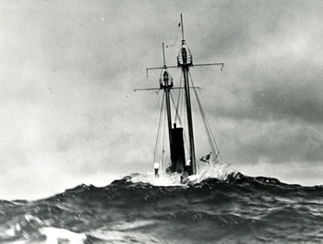Crew Quotes
Accounts of duty from LV-112 crew members
Below are accounts of duty on the Nantucket Lightship LV-112 from former crew members. Normal duty on the 112 and most other isolated stations would be three weeks on and then two weeks off. The crew was split into thirds, with crews overlapping. The only time the three weeks on duty were extended, was due to weather. (The returning crew had to literally jump from the 'tender' to the lightship via a jacobs ladder as they came along side. The ships stores would need to be replenished more often than 6-8 weeks, normally at least every two weeks ).
Twenty-one former LV-112 crew members live in different parts of the country. Bernie Webber, who served on LV-112 from 1958–60 was awarded the Gold Life Saving Medal for his involvement in the oil tanker Pendleton disaster that occurred off Cape Cod's Monomoy Island ("A true USCG hero," said Larry Ryan, President, USCG LSA, USCG Lightship veteran, 1960–61). Unfortunately, Mr. Webber, recently and unexpectedly passed away in January of this year. He was very helpful and involved with the LV-112 rescue and preservation effort.
Several of the former crew members who served on LV-112 as engineers, electricians and deckhands have offered to volunteer their time as part of a riding crew when the ship is relocated to its home port.
Bernie Webber
"I was stationed aboard LV112/WAL534 Nantucket/Relief 1958-59-60 as Chief Executive Petty Officer. Let me say this it was the best coast guard duty I had. I'm taking the photo of the crew (see LV-112 Photo Gallery) so I'm not in it. The Lightship at the time being steam powered had the largest crew of any Lightship and ratings like Machinest Mates that the other Lightships didn't have."
"The Nantucket Station was 100 miles offshore from Woods Hole MA-45 miles SE of Nantucket Island at the time and was the easternmost Navigational Aid all shipping would make Nantucket Station before branching off to New York etc. However the Station was in various locations during its history. As a Relief Lightship it relieved stations from Portland Maine to Brenton Reef Rhode Island and was at the entrance to the harbors or right in the shipping channels."
"Having spent some 45 yrs on the water it's difficult to think in terms of most pleasurable or terrifying. However, on LV112/Wal535 Nantucket/Relief my most pleasurable was the day when the Captain Robert J.W. Collins received a message while we were on Nantucket Station (100 miles off-shore from Woods Hole, MA) that we were being relieved and brought in to become a Relief Lightship.The only terror I felt was when on Nantucket Station in rough foggy weather a Radar Target would be observed headed directly towards the Lightship as it got close you could hear its engines and soon out of the fog so close you could spit on it would come one of the great liners sailing the seas at the time like the S.S. United States or S.S. France etc."
— Bernard Webber, former LV-112 crew member, 1958-1960
Bob Gubitosi
“I went aboard Light Vessel #112 on a foggy day in 1957. I was 17 years old and saw this big red ship with 'Nantucket' painted on it anchored in the calm sea belching out the most ear-piercing foghorn I have ever heard. I think it was then that I realized that my life was about to change. I was the ship's new cook and had to feed 15 men aboard this ship, and I just came from commissarymen school at Groton, Connecticut, where they taught me to feed about a thousand. This was a terrifying experience at that time. I was on the 112 until 1961. I could not get a transfer and had four different skippers during my tour. There were many storms and hurricanes. One scary night was in, I believe 1958, when we broke our anchor chain and did not know it. We wound up off the coast of New Jersey the next day with our radio beacon still going. I remember going on the bridge that night and watching the ship through the porthole going up walls of water that looked like five- to ten-story buildings high, then taking a nose dive straight down. The most pleasurable time was when the mail came, the few calm summer days without the fog horn, the fishing, watching the aurora borealis and the sea life.”
— Bob Gubitosi, 2nd VP, USCG LSA, LV-112 Commissaryman (ships cook) 1957–61
Rich Racicott
“During one nor'easter, I remember the skipper and I were on the bridge watching the anemometer. It was marked 0 to 100, but gusts were pushing the needle into the space above 100 and against the pin on the dial. We joked about it for a while and then it dropped to zero and moments later we heard a crash. Seems that the anemometer blew off the yardarm, must have bounced once somewhere on the deck then disappeared over the side. We never found it.”
— Rich Racicott, crew member LV-112, 1964-66
Peter Brunk
“The worst thing that happened was going through a bad storm the first week of March 1971. My father died on March 7, and they couldn't get me off the ship for over a week. We left Boston on the 6th and storm warnings were up. When we got to station, the Relief Lightship didn't leave for almost a week, so we had two lightships on Nantucket station. The wind blew at over 100 mph for a week. Another interesting event happened in April or May 1970. An American submarine hit the ship with what we think was a dummy torpedo. We were on the corner of the New London sub-operating area, and they were around us a lot.”
— Peter Brunk, Commanding Officer, LV-112, 1970–71

